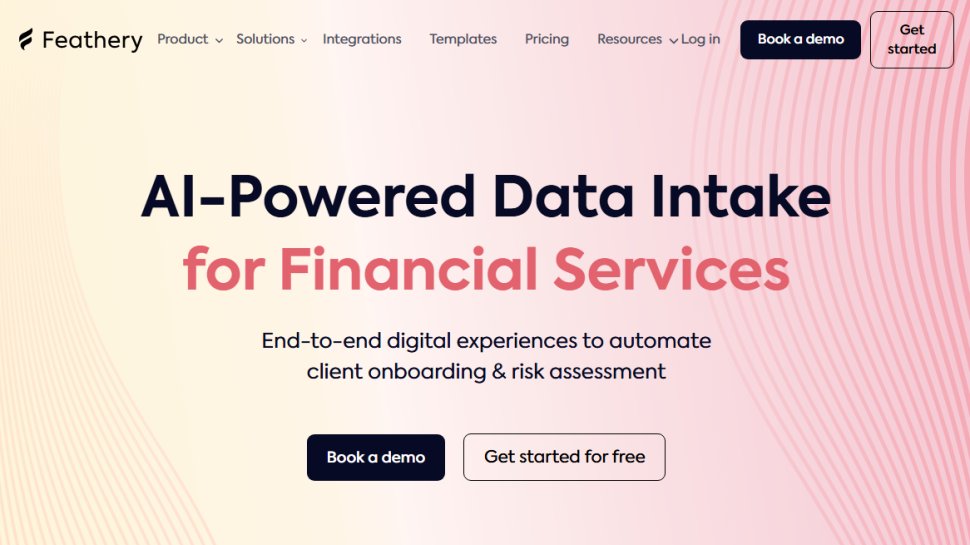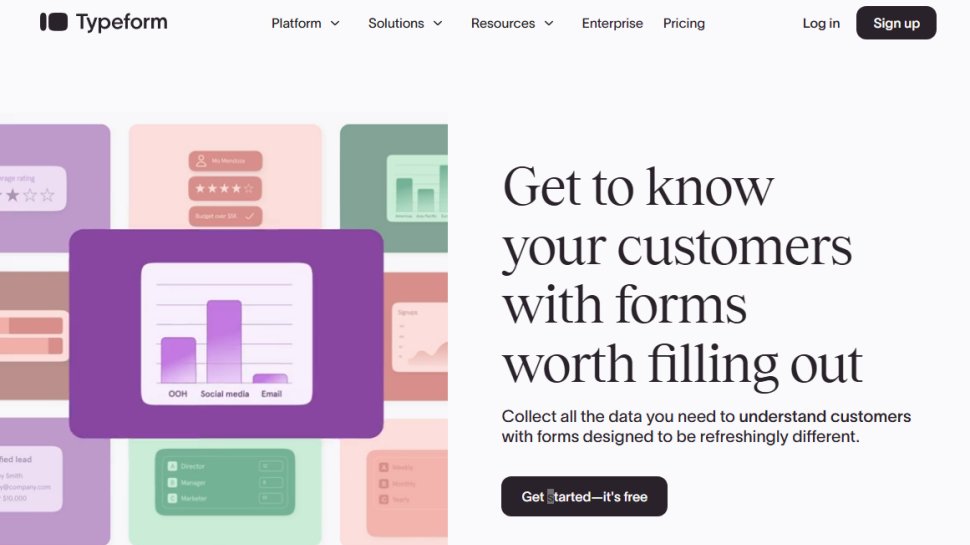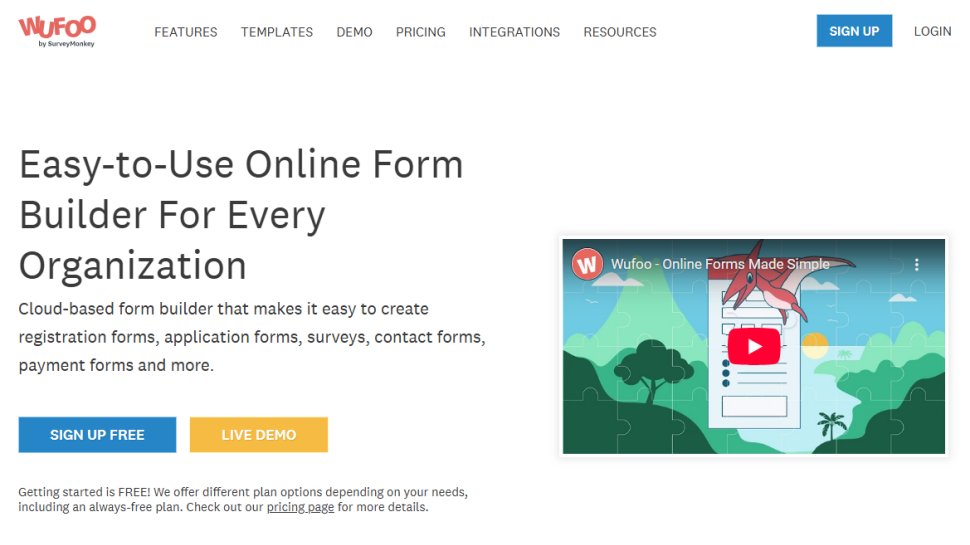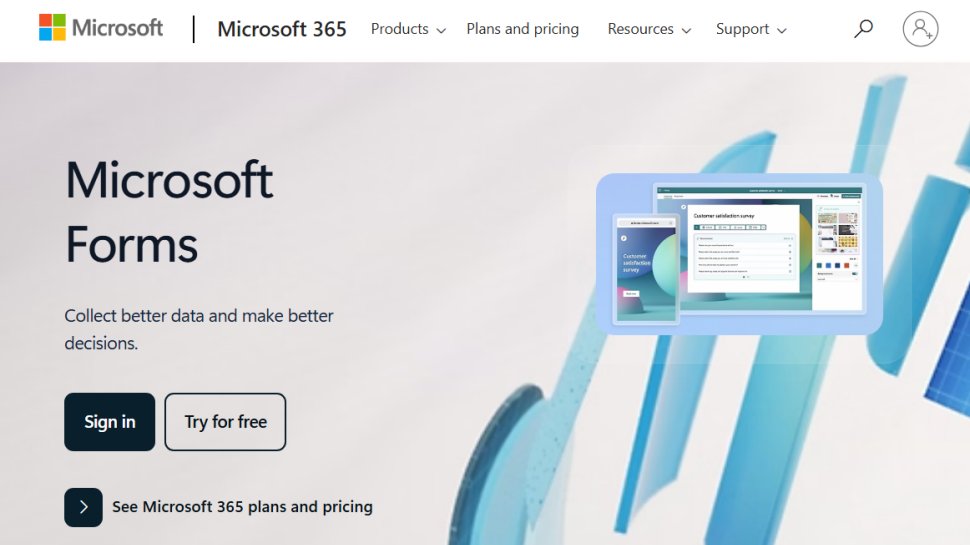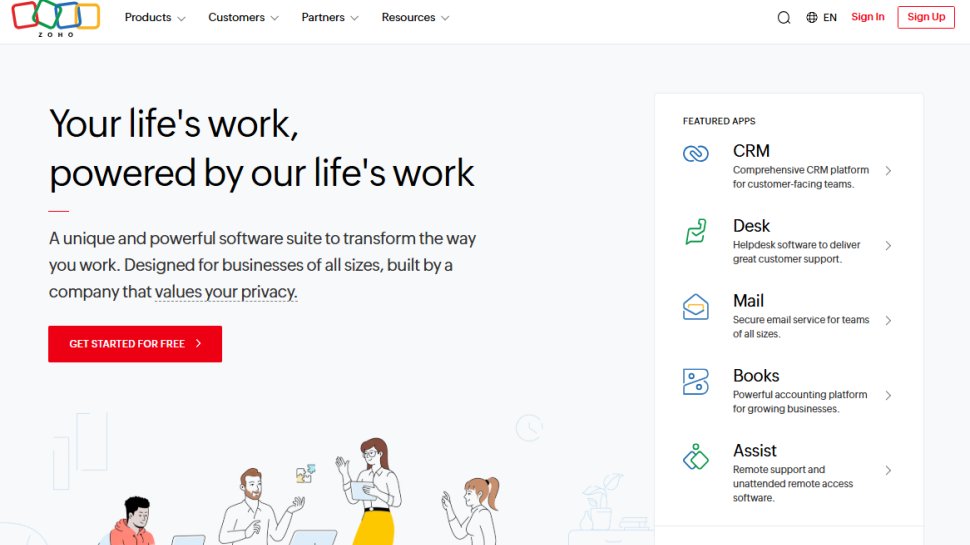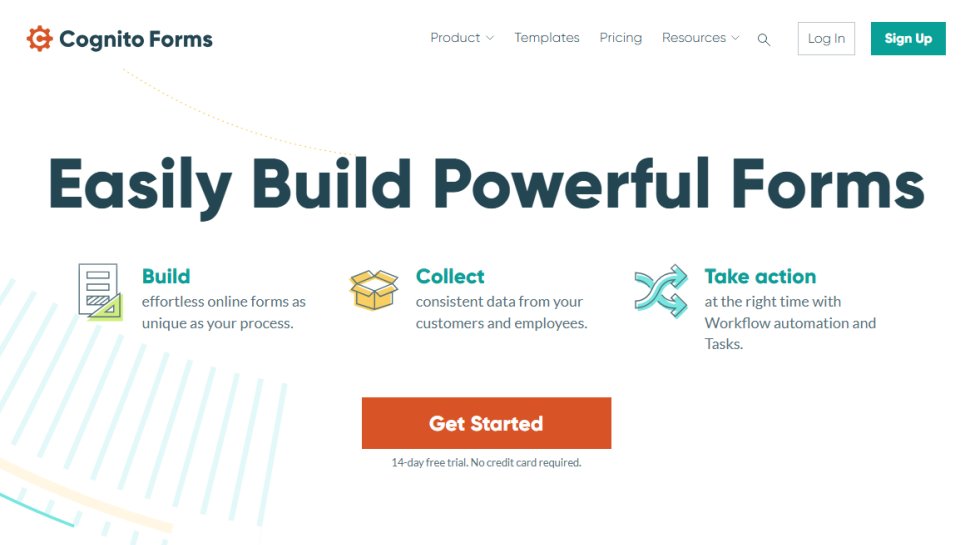Best online form builder of 2025
Design forms to collect customer feedback

We list the best online form builders, to make it simple and easy to collect, organize and analyze website data such as customer feedback and marketing analytics.
All of the best online form builders we list below make it easy to collect customer feedback and marketing data with forms that are easy to create and complete.
Every business can benefit from collecting more data, but all too often it can be a laborious process - this is where form building platforms come in.
Our team of experts have spent hundreds of hours testing the best online form builders on the market. Below we have listed our top picks and condensed everything you need to know into a short review of each.
The best online form builders find a use everywhere. You'll commonly find them used in project management software, the best CRM software, and as an optional extra tool for the best website builder platforms.
Reader offer: Enhance your form-building process with Jotform Enterprise
A game-changer in form workflow management. Jotform Enterprise lets you effortlessly create, customize, share, and analyze forms in a collaborative workspace. Use conditional logic, payment acceptance, and workflow automation. Track responses in a spreadsheet, generate comprehensive reports, and automate e-sign forms—all in one platform. Integrate with +150 business apps, securely host data locally, import existing forms, and more, all while reducing costs and eliminating paper form hassles.
Preferred partner (What does this mean?)
The best online form builder of 2025 in full:
Why you can trust TechRadar
Read on to discover all the pros, cons, tools, and features of the best online form builders.
Best online form builder overall
Reasons to buy
Ideal for businesses of all sizes, JotForm helps companies create survey forms without any knowledge of CSS, JavaScript or other programming languages – though if they do, there’s plenty of scope for diving into the code and tweaking designs.
Forms are highly customizable and can be set to show different content based on users’ location, and field types can be further customized to show properties as required, setting character limits and pre-populating fields. There is a free trial available.
JotForms also allows you to create forms using the power of AI. This works in a similar way to the best AI website builders, simply describe what you are looking for and the AI will work behind the scenes to create your form for you.
It might take you some time to master JotForms advanced features, such as CRM integration or workflow management. You don't have to dig into that kind of detail unless it's really necessary, though, and overall JotForms is a great form building choice for every level of user.
Read our full JotForm review.
Best comprehensive online form builder
Reasons to buy
Formstack has worked with over 25,000 organizations so far, and its survey shows that people who use Formstack save up to 18 hours a week.
A stack of appealing features includes an easy drag-and-drop form builder, form templates, and integration options. The highlight, though, is Formstack’s Enterprise plan, where you get a dedicated success manager for your company. In simple terms, it means that instead of overseeing the process yourself, you’ll have someone from Formstack to help your progress.
Formstack also offers a great deal of payment options. Unlike Cognito Forms which limits your payment choices to 4 — PayPal, Stripe, Cards, and Square Payments — Formstack gives you access to as many as 15 platforms which include WePay, Stripe, Paymill, and so on.
I like the responsive forms, which resize themselves depending on the device you’re using. So whether it's a phone, tablet, or laptop, the form will look and work just the same on all devices.
Apart from the “Forms” plan, there are two more Formstack plans: Documents and Sign. These plans are exclusively meant for document-focused workflow management and obtaining e-signatures, respectively. You can either subscribe to these plans individually or opt for the Suite plan, which merges the benefits of all three plans.
Under Document Automation, you can use the data you have collected through forms to automatically create a personalized document. And through e-signatures, you can send a document to the concerned user and have them sign it from the comfort of their home.
Read our full Formstack review.
Best online form builder for privacy
Reasons to buy
Reasons to avoid
Feathery shines through with its form building options. A host of templates gets you up and running at speed; there's an easy-to-use drag and drop builder to create your own design; Feathery even has an AI assistant, where you enter your own prompt, and it creates a unique, personalized form within seconds.
However, what truly makes Feathery stand out is its security protocols and customer support team. For security, Feather is compliant with SOC 2 (System and Organization Controls 2) — a standard for internal security controls and data management policies, HIPAA (Health Insurance Portability and Accountability Act), which prevents the company from sharing personal and medical information of a user, and GDPR (General Data Protection Regulation), the toughest privacy and security law in the world that oversees personal data collection and management.
In short, Feathery is one of the safest, privacy-centric online form builders.
Speaking of customer support, you get tons of options to choose from. First, you have email support which is available on all plans. Next, you have its thriving Slack community, where you can talk to fellow Feathery users and resolve any obstacles you run into on the fly. For expert help, you can also seek priority support over live chat.
Read our full Feathery review.
Best designed online form builder
Reasons to buy
Reasons to avoid
Typeform is not just limited to forms alone; you can also use it to create polls and even quizzes. If your target audience doesn't have time to fill out a detailed form (which they might then just abandon), Typeform's polls allow them to share their feedback with just one click.
In simple terms, having a versatile platform like Typeform is a great way to communicate with different types of target audiences.
The most notable feature of this platform is Recall Information. You can use this to extract answers from previous questions in the form and include them in the next question. For example, if you ask a customer about their favorite part of the shopping experience at your online store, you can use the Recall Information feature to design more questions around their answer to understand their opinion better.
What’s more, it integrates with 500+ apps, including Pipedrive, HubSpot, Google Sheets, and so on. Compared to other platforms like Formstack and Cognito Forms that can only connect with some 200-odd apps, 500 integrations is a huge boost. Integrations, especially with business apps, help you centralize major day-to-day processes and get a bird-eye-view of your projects.
Read our full Typeform review.
Best for data collection
Reasons to buy
Reasons to avoid
Wufoo is one of the few tools on the list that lets you create password-protected forms, meaning your users will be required to enter a password before they can access the form. This feature is usually used by banks and financial institutions when the content of the form is sensitive.
For further protection, you can also encrypt individual form fields. You can use this feature to protect confidential answers like phone numbers, address and ID numbers, and other crucial information that shouldn't leak.
Another notable benefit of using Wufoo forms is custom form endings. There are form builders that allow you to redirect the respondent to a different page, while some of the others help you create a Thank You page. Wufoo, on the other hand, lets you do both. This feature isn't unique to Wufoo — Zoho Forms does the same, but it's still worth noting.
A capable attachment feature allows respondents to upload files of up to 25MB to the form. If that's not enough, buying the Professional and higher plans increases the limit to 100MB.
Wufoo also has a completely free plan that provides up to 5 forms every month, unlimited reports, and email support.
Read our full Wufoo review.
Best affordable online form builder
Reasons to buy
Reasons to avoid
Microsoft Forms is near-perfect for those looking for an affordable yet feature-rich option. Microsoft Forms starts at just $6/user/month, which is very, very cheap when compared to industry leaders like Formstack and Cognito Forms.
Now, Microsoft doesn’t sell its form builder as a separate product — it's part of the Microsoft 365 suite, which will also give you access to other tools like Microsoft Word, Excel, Outlook, Teams, SharePoint, and so on.
Speaking of features, the biggest advantage of using Microsoft Forms is its superior data analysis features. The platform automatically makes pie charts out of the available data to simplify the calculation. Let's say you sent out a survey form asking for feedback on your latest product. Instead of manually counting who liked your product and who didn't, you can simply check the pie charts created by Microsoft Forms.
For more advanced data analysis, you can use Forms Ideas — a multi-faceted data analytics tool in Microsoft Forms. One of its best-known features is the cross-distribution analysis which helps you compare answers across different groups of respondents. Suppose you have sent out a job satisfaction form to your employees. Now, with the cross-distribution analysis, you can check how satisfied the members of a certain department are compared to another department.
Microsoft Forms also lets you add videos and images to the questions. This feature can help educational institutions host online classes and create more engaging quizzes for students or businesses to take user feedback on a new product design.
Read our full Microsoft Forms review.
Best online form builder for email automation
Reasons to buy
Zoho Forms is the ideal platform for businesses looking to automate common email management tasks and save themselves a huge amount of time.
Say you've sent out forms about an upcoming charity event, for instance. Other services might leave you hunting through a pile of negative responses to find whatever you need. But set up Zoho Forms' Email Workflow to detect when someone is interested, and it'll automatically forward a suitable response, without you needing to do any more work at all.
Automated workflows can handle this, even with the most complex of business rules. Whenever a new form submission comes in, Zoho Forms can route this through a hierarchical chain of employees to approve the form’s content before an automated email is sent to the respondent.
Working with a team on Zoho Forms is quite easy, thanks to its team-friendly interface. You can assign forms to your employee and adjust the permission settings to decide what fields they can view and edit. Zoho also allows two or more employees to collaborate together and share the workload — depending on the plan you choose, you can add up to 100 users at once.
Another remarkable benefit of using Zoho Forms is document merging. While Formstack offers this feature under a separate plan, Zoho combines it with its subscriptions for form builder. The process is simple — once you have a new form submission come in and it's approved, you can use the document merging feature to extract personal details from the form and personalize the document.
Read our full Zoho Forms review.
Best unlimited online form builder
Reasons to buy
Cognito Forms is ideal for large businesses that have lots of user queries and responses coming in and need a bigger team to manage them. It lets you add up to 20 users, depending on the plan you choose.
Another benefit of using Cognito Forms is the massive storage space it provides. While it's not as impressive (only 100MB) on its free plan, as you move to the Teams or Enterprise plan, you get up to 10GB and 100GB of space, respectively, to store your forms and responses.
Speaking of the free plan, Cognito Forms doesn’t hold back and gives you unlimited forms, seamless payment integration with Stripe, and custom document templates. Once you move up to the paid plans, your integrated payment options expand to PayPal, Square Payments, and Credit-Debit cards.
Cognito Forms is also very sincere about your data security and takes appropriate measures. You can set up two-factor authentication to prevent unauthorized access, and you get audit trails of 1 week to 2 years (depending on the plan) where you can see all the changes made to the data — hiding a mistake or covering up data fraud is simply impossible with this feature.
Read our full Cognito Forms review.
Best online form builder FAQs
Are there any form builders that work offline?
Platforms like Zoho Forms and Formstack work offline, giving your team access to form templates, customization options, and field options. You can also collect the data from the responses and store them locally on your device. Once your internet connection is back, the form data will be uploaded to your chosen cloud automatically. This way, your work will not come to a halt even if you temporarily lose your internet connection.
What is an online form builder?
Online form builders help make the job of collecting data easy. To get started simply pick one of the platforms from above, sign up, select a template and then drag and drop the elements you need until the page looks and works the way you want. Then, once live, you can use the built in tools to collect and analyze your responses.
This approach to form creation and data collection can save you considerable time when compared to coding your own forms or using manual methods such as paper and pen.
Are there any free form builders?
Many well-known online form builders come with a free plan: Typeform, Feathery, and Cognito Forms are just a few examples. Just like the best free website builders, each platform has its own set of features and limitations for free plans. For example, Cognito Forms provides one of the best free plans in the industry, where you get access to unlimited forms, 100MB of storage to store form data, and 500 entries per month.
How do online forms prevent data leaks?
Online form builders deal with tons of personal user data and employ multi-layered security to prevent leaks. Platforms like Cognito Forms come with 2FA (two-factor authentication) to prevent unauthorized users from accessing respondents’ data. Similarly, Feathery is compliant with SOC2, HIPAA, and GPR, which together ensure that the platform won’t share confidential user details with a third party.
How can you distribute your online forms?
There are many ways to distribute the forms once they have been created. You can embed it in your website, making it available to everyone who visits your page. You can also share it on your social media handles as Facebook posts or Instagram Stories. In case you want to target a very specific group of customers, share it on your mailing list via integrations like MailChimp.
Are there any additional discounts on the price?
Most form builders either provide a free plan or a free trial — the best place to start if you’re on a tight budget. However, if you want the paid features at a discounted rate directly from the company, you must be a nonprofit. For example, Zoho Forms have come forward with an initiative to help non-profit organizations with discounted rates. You can contact their support to know more about this. The same is true for Cognito Forms.
Can I integrate online form builders with my existing CRM or other third-party tools?
Yes, some form builders will allow you to integrate with third-party tools such as CRM. For example, Jotform can be used in conjunction with CRMs including HubSpot, Zoho, and Salesforce. Doing this can help streamline data collection, analysis, and help inform data-based decision-making.
How to choose the best form builder?
The biggest reason why you might want to use an online form builder is to save time and simplify your work, so look for a service that’s easy to set up and use.
Tools like Formstack are a little more technically challenging than others. For instance, creating custom validation messages on Formstack requires Javascript knowledge. On the other hand, platforms like Zoho Forms let you do it without codes. If you’re tech-savvy and more customization options sound like something you’d like, form builders like Formstack will be a delight for you but for normal usage, simple tools should be the way forward.
You should also look for the extent of automation opportunities in a given platform. It makes no sense to pay for a tool if you have to do all the mundane, repetitive tasks yourself.
Another important criterion is pricing. There are free form builders, form builders that are reasonably priced, and some that are expensive and exclusively designed for large organizations. See what works best for your needs and choose accordingly.
How we tested the best online form builders
We followed a stringent testing process where we checked several aspects of all the form builders. The first thing we checked was the signup process. We consider tools that require no more than a few minutes to sign up and don't ask for too many details upfront.
Next, we head to the main form builder, where we experiment with the templates and customize fields, options, and confirmation messages to see if it's easy enough for everyone to use. Customization options were another criterion we prioritized.
Much of our testing was around the features offered by these tools, including payment integration, e-signatures, and more. We also looked at the sharing options a platform provides — whether you can share your forms on social media, email lists, or embed them on a website. This is where we usually notice the biggest difference among all the form builders.
Finally, we check how the platform helps you with post-data collection, like data analysis and export. Some of the options, like Formstack, give you stats on user behavior, like total visitors, abandonment rate, response time, and more. Other tools like Microsoft Forms help you calculate the data with charts. Every tool above has at least some way of helping you with data processing.
Read how we test, rate, and review products on TechRadar.
Get in touch
- Want to find out about commercial or marketing opportunities? Click here
- Out of date info, errors, complaints or broken links? Give us a nudge
- Got a suggestion for a product or service provider? Message us directly
Sign up to the TechRadar Pro newsletter to get all the top news, opinion, features and guidance your business needs to succeed!

Désiré has been musing and writing about technology during a career spanning four decades. He dabbled in website builders and web hosting when DHTML and frames were in vogue and started narrating about the impact of technology on society just before the start of the Y2K hysteria at the turn of the last millennium.
- Owain WilliamsB2B Editor, Website Builders & CRM



